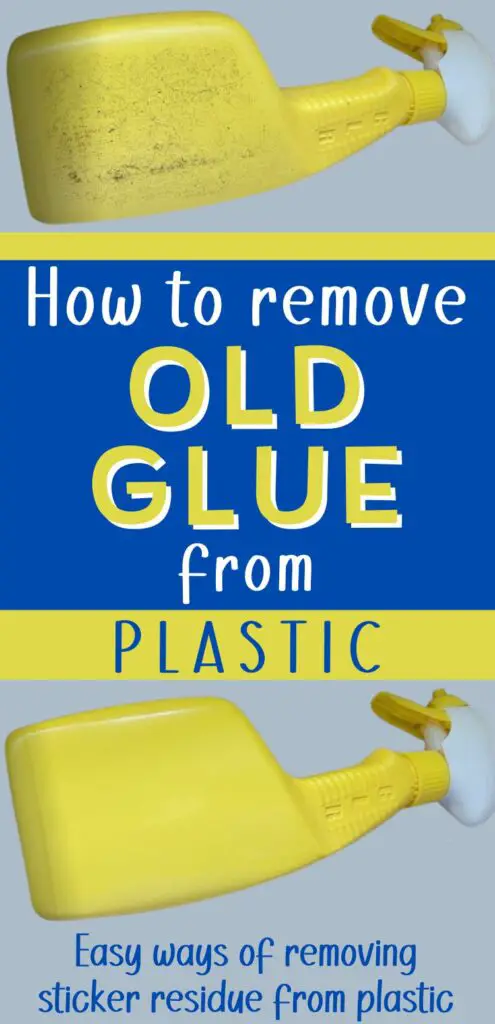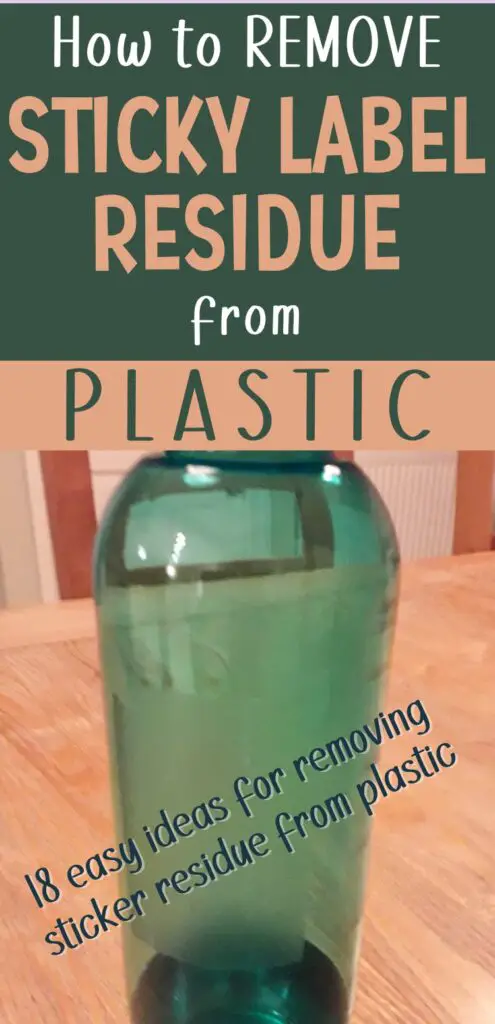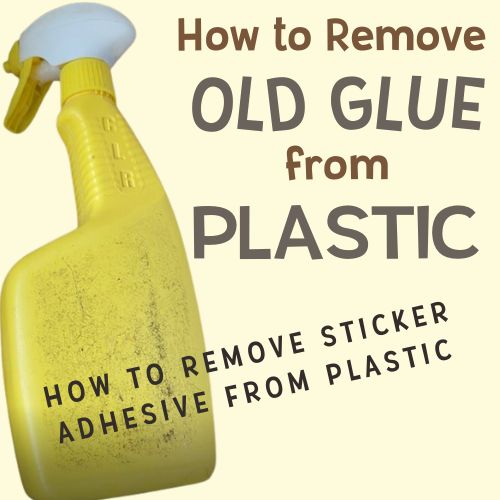18 easy ways to get sticky residue off plastic
The other day, I was cleaning and wanted to reuse a plastic spray bottle that had a tattered, old sticker label glued to it. When I removed the label, I was left with a sticky residue that wouldn’t come off. I was trying to scratch it off with my fingernails, and I found that it was a frustrating and time-consuming process. But it doesn’t have to be!

How to Remove Glue Residue from Plastic
After trying a few different methods, I discovered an easy way to remove the old glue without damaging the plastic surface. I wanted to share my experience and give you some tips on how to remove old glue from plastic using simple household items.
These methods can also be used for the same purpose on glass surfaces.
As an Amazon Associate I earn from qualifying purchases. This means if you click on a link and buy something I’ve recommended, I get a small commission at no additional cost to you. You can see my full Disclosure Policy here.
How to Remove Sticky Residue from Plastic
I found that there are 6 categories of glue remover:
- Solvents
- Oils
- Abrasives
- Acids
- Heat
- Commercial Products
I drilled down into the different categories and tried some myself. Here’s what I found:
Use Solvents to Remove Dried Glue from Plastic Surfaces
Solvents are chemicals that dissolve adhesives, making them easier to remove. Examples include rubbing alcohol, acetone (found in nail polish remover) and even lighter fluid. In my experience, they are the quickest and easiest way to get rid of sticky residue from plastic surfaces.
Alcohol
Rubbing alcohol and vodka are solvents that are an easy and effective way to remove old glue from the plastic surface.
Rubbing alcohol, like vodka, is easily accessible, inexpensive, and dries quickly, making it a convenient solution for removing sticky glue from plastic. It is also generally safe to use on most types of surfaces.
Hand Sanitizer
Hand sanitizer contains alcohol and aloe vera gel and can be applied directly to the sticky residue on plastic and is a good alternative to alcohol.
While hand sanitizer will remove sticker residue, you will have to wash the area afterwards to remove the gel.
Acetone (Nail Polish Remover)
Acetone is another useful solvent that breaks down any sticky residue it comes into contact with. It’s the main ingredient in nail polish remover.
If you choose to use nail polish remover to get glue residue off plastic, work quickly as acetone can damage some plastics. Use it in a well-ventilated area and avoid prolonged exposure, as it contains harsh chemicals.
Lighter Fluid
If you don’t have any of the above household solvents, lighter fluid will work in a pinch. You will need to work quickly as the lighter fluid could damage the surface.
How to Use Solvents
When using solvents to easily remove dried glue from plastic surfaces, here’s a few simple steps to get a smooth finish:
- Soak a paper towel, cotton ball or cloth in one of the following solvents and apply it directly onto the sticky residue on the plastic surface. Make sure the glue is fully saturated with the solvent.
- Let the solvent sit on the glue for a few minutes to allow it to break down the glue.
- After a few minutes, use a cloth or paper towel to wipe away the softened glue. If the glue is still stuck, use a plastic scraper (or an old credit card) to gently scrape away the remaining residue.
- Repeat if necessary. If the glue is particularly stubborn, you may need to repeat the process a few times to fully remove it.
Solvents are flammable so use with caution and keep away from open flames. It’s also a good idea to use them in a well ventilated area to minimize fumes.

Use Oils to Dissolve Sticky Residue on Plastic Surfaces
Many types of glue are oil-based adhesives and oil dilutes glue, just like water dilutes water-based paint.
Cooking oil
You can use any type of cooking oil including vegetable oil, olive oil, and coconut oil. Cooking oil is a safe and non-toxic way to remove adhesive from plastic surfaces, making it a great option for those who prefer natural cleaning methods.
Peanut Butter
Peanut butter is another oily substance that can safely be used to remove old glue from plastic when cooking oil isn’t available.
Peanut butter can leave behind a residue that may need to be cleaned off after the adhesive is removed. Use with caution if you are in proximity to someone with a peanut allergy.
Petroleum jelly
Petroleum jelly works in a similar way to oil when it comes to removing adhesive from plastic.
Petroleum jelly may take a little longer to work on dissolving sticker adhesive from plastic, but should be effective if you are patient.
How to Use Oils
The following steps should be taken when removing glue from plastic surfaces using oil:
- Apply a small amount of oil directly to the adhesive, making sure to cover the entire area.
- Allow the oil to sit on the adhesive for 10-15 minutes to break down the glue.
- After the oil has had time to soften the adhesive, use a cloth, paper towel or even a soft brush in circular motions to gently wipe away the adhesive. If the adhesive is still stuck, use a plastic scraper to gently scrape the glue residue away.
- Once the adhesive is removed, clean the plastic surface with soap and water to remove any remaining oil.
- After the adhesive is removed and the surface is cleaned, rinse the plastic with water and dry it with a clean cloth.
Try to avoid using too much oil, as it can make the plastic slippery and difficult to handle.
Use Abrasives to Remove Glue from Plastic
It’s a good idea to wash the plastic item in hot, soapy water for 15 minutes to soften the glue before using abrasives to get glue off plastic. Dry it completely before using the abrasive.
Baking soda and coconut oil
Baking soda combined with oil forms a paste that’s easier to work with than just runny oil. The abrasive nature of the baking soda also acts as a scourer to help to loosen the glue.
- In a small bowl, mix together equal parts baking soda and coconut oil until a paste forms.
- Using your fingers or a cloth, apply the paste to the glue, making sure to cover the entire area.
- Allow the paste to sit on the glue for 5-10 minutes to break down the adhesive.
- After the paste has had time to work, use a cloth or paper towel to wipe away the glue. If the glue is still stuck, use a plastic scraper to gently scrape away the remaining residue.
- Once the glue is removed, clean the plastic surface with soap and water to remove any remaining paste.
- After the glue is removed and the surface is cleaned, rinse the plastic with water and dry it with a clean cloth.
Baking soda is non-toxic and food-safe, making it a great solution for removing sticker residue for those who prefer natural cleaning methods.
Sandpaper
Sandpaper can be used to sand down the surface of the plastic and remove the residue. It’s important to be gentle and use a fine-grit sandpaper – 400 or more – to avoid scratching or damaging the plastic.
Steel wool
Steel wool can be used to gently scrub away the residue. Again, it’s important to be gentle and use a fine-grade steel wool like #0000 to avoid damaging the plastic.
Magic Eraser
A Magic Eraser is a melamine foam abrasive that can be effective for removing stubborn glue residue. It should also be used gently to avoid scratching the plastic surface.
Use Acids to Remove the Glue on Plastic
Vinegar
When vinegar (a mild acid) comes into contact with adhesive, it reacts with the glue’s chemical composition, weakening it and making it easier to remove.
- Soak a paper towel or clean cloth with vinegar and leave the cloth over the glue to soften it. Or you could pour some vinegar in a bowl large enough to hold the plastic item and soak it directly in the vinegar. Let soak for 15 minutes.
- After the vinegar has had enough time to soften the adhesive, use a cloth or paper towel to wipe away the adhesive. If the adhesive is still stuck, use a plastic scraper to gently scrape away the remaining residue.
- Once the adhesive is removed, clean the plastic surface with soap and water to remove any remaining vinegar.
- After the adhesive is removed and the surface is cleaned, rinse the plastic with water and dry it with a clean cloth.
I found that this method was slower and I had to do a lot of scraping. However, it’s a safe and non-toxic way to remove old glue from plastic and works when you use a lot of elbow grease.
Citric Acid
Citric acid, like vinegar, is a mild acid. However it is stronger than vinegar and may get the job done a little more quickly.
- Prepare a citric acid solution by mixing 1 tablespoon of citric acid with 64 oz of hot water in a bowl or spray bottle.
- Soak a paper towel or clean cloth with the citric acid solution and leave it on the glue and let it sit. Or place the plastic item in a bowl and soak it directly in the citric acid solution. Let soak for 15 minutes. While you’re waiting, here’s 21 unbelievable DIY cleaning uses for citric acid that you can use the rest of the cleaning solution for.
- After the citric acid has had enough time to soften the adhesive and the glue residue is lifting, use a cloth or paper towel to wipe away the adhesive. If the adhesive is still stuck, use a plastic scraper to gently scrape away the remaining residue.
- Once the adhesive is removed, clean the plastic surface with soap and water to remove any remaining citric acid solution.
- After the adhesive is removed and the surface is cleaned, rinse the plastic with water and dry it with a clean cloth.
I found that this method was slightly faster than using vinegar and I didn’t have to do as much scraping. I’m not sure if it’s because it’s a stronger acid or if the hot water helped to soften the adhesive more.
Use Heat to Remove Labels off a Plastic Surface
Hair dryer
Working on the assumption that hot water helped to soften the adhesive, I tried using a hair dryer to heat it up instead.
- Set your hair dryer to the hottest setting.
- Hold the hair dryer a few inches away from the plastic item and aim the hot air directly at the adhesive.
- Move the hair dryer around the adhesive, heating it up evenly for about 30 to 45 seconds. This will help loosen the adhesive and make it easier to remove.
- Use a plastic scraper to scrape off the glue residue.
- If there is still adhesive residue left on the surface, continue heating it with the hair dryer and using the plastic scraper to gently scrape it off. Be careful not to scratch or damage the surface.
- Once the adhesive is removed, clean the plastic surface with soap and water to remove any remaining residue or dirt.
This method worked, but it took some time. Be careful when using a hair dryer, as the hot air can cause the plastic to melt if not used properly.
Use Commercial Products to get Sticky Residue off Plastic
Commercial products that are specifically designed to remove glue residue from surfaces can be effective options because they contain ingredients that are designed to remove sticker residue. These products have been extensively tested to ensure that they are safe to use on plastic surfaces and are often effective at removing even the toughest adhesive residues. In addition, they are usually easy to find and purchase at most hardware or home improvement stores.
Goo Gone
Goo Gone is a good option to remove glue from plastic because it is designed to quickly and simply remove sticker residue from hard surfaces like glass, wood, plastics, and porcelain.
- Apply a small amount of Goo Gone directly onto the glue you want to remove, making sure to cover the entire area.
- Allow the Goo Gone to sit on the glue for 5-10 minutes to break down the adhesive.
- After the Goo Gone has had time to work, use a cloth or paper towel to wipe away the glue. If the glue is still stuck, use a plastic scraper to gently scrape away the remaining residue.
- If the glue is particularly stubborn, you may need to repeat the process a few times to fully remove it.
- Once you have removed all the glue, clean the plastic surface with soap and water to remove any remaining Goo Gone.
- After the glue is removed and the surface is cleaned, rinse the plastic with water and dry it with a clean cloth.
Overall, Goo Gone is a powerful adhesive remover that can effectively eliminate old glue from plastic. It contains some toxic chemicals, so it’s important to use the product as directed and avoid prolonged exposure.
WD-40
WD-40 can be used to remove glue from plastic as it is a lubricant (fish oil to be exact) combined with a solvent, making it an ideal solution.
- Spray a small amount of WD-40 directly onto the glue, making sure to cover the entire area.
- Allow the WD-40 to sit for 5-10 minutes to break down the adhesive.
- After the WD-40 has had time to work, use a cloth or paper towel to wipe away the glue. If the glue is still stuck, use a plastic scraper to gently scrape away the remaining residue.
- Once the glue is removed, clean the plastic surface with soap and water to remove any remaining WD-40.
- After the glue is removed and the surface is cleaned, rinse the plastic with water and dry it with a clean cloth.
Like Goo Gone, WD-40 contains some harsh chemicals, so you should use the product in a well-ventilated area and avoid prolonged exposure.
What’s the best way to remove sticker residue from plastic?
I found that rubbing alcohol is the fastest and easiest way to remove old glue from plastic because it is a solvent. Common adhesives such as craft glue, wood glue, hot glue, super glue, gorilla glue and even epoxy are soluble in alcohol. Rubbing alcohol also evaporates quickly, which means that it doesn’t leave any residue that needs to be cleaned from the plastic and it won’t damage the plastic surface. It’s also easy to find and can be found in most homes.
Rubbing alcohol is also relatively non-toxic, which makes it ideal for use in households with children or pets. Unlike some other chemical solutions, rubbing alcohol is unlikely to cause any harm if ingested or inhaled in small quantities. Overall, rubbing alcohol is a simple and effective way to remove old glue from plastic, and is a great option for anyone looking for a fast and easy solution to removing sticker residue from plastic.
How to remove old gorilla glue from plastic?
I found the fastest and easiest method was using a solvent such as rubbing alcohol, vodka or acetone. However, any one of the above mentioned methods should remove old gorilla glue from plastic.
How to remove old super glue from plastic?
If you’re in a sticky situation with some superglue, rubbing alcohol is my favorite method for removing old super glue from plastic. It works very quickly to soften the old super glue and it just wiped away.
More Tips to Remove Sticky Tape Residue
When Using Solvent
- Before applying the solvent to the plastic surface, test it on a small, inconspicuous area to make sure it won’t cause any damage or discoloration.
- Many solvents emit fumes that can be harmful if inhaled, so it’s important to work in a well-ventilated area or wear a respirator.
- Apply the solvent to a cloth or cotton ball, rather than directly to the plastic surface. This will help you control the amount of solvent that you are applying and prevent it from spreading to other areas.
When Using Oils
- Generally, vegetable oils such as coconut, olive, or vegetable oil work well.
- Apply a small amount of oil to a clean cloth or cotton ball, and then apply it to the adhesive residue. Avoid applying too much oil, as it can make the plastic slippery and difficult to handle.
- Allow the oil to sit on the adhesive residue for several minutes to allow it to penetrate and loosen the adhesive.
- Use a soft-bristled brush or a cloth to gently scrub the adhesive residue in a circular motion. Be careful not to scrub too hard, as this can scratch the plastic.
- Once you have removed the adhesive residue, use a clean cloth to wipe away any excess oil. Finally, wash the plastic surface with soap and water to remove any remaining residue and oil.
When Using Abrasives
- Test the abrasive in a small and inconspicuous area to ensure it does not damage the plastic surface. If there is no damage, proceed to apply the abrasive to the adhesive residue.
- Apply the abrasive in circular motions and avoid applying too much pressure, as this can damage the plastic surface.
- Once the adhesive residue is removed, rinse the plastic surface thoroughly with water and wipe it clean with a damp cloth. This will remove any excess abrasive particles.
When Using Acids
- Use a mild acid such as vinegar or citric acid as these mild acids are less likely to damage the plastic.
- Before using any acid on plastic, test it in a small and inconspicuous area to ensure it does not damage the plastic surface.
- Use a soft cloth to apply the acid to the adhesive residue. Soak the cloth and leave it on the adhesive area for some time to allow softening.
- After applying the acid, rinse the plastic surface thoroughly with water and wipe it clean with a damp cloth. This will remove any excess acid and prevent it from damaging the plastic.
When Using Heat
- Apply heat evenly to the entire adhesive residue area to soften it up. Avoid concentrating heat on one spot for too long as this can cause the plastic to melt or warp.
- Once the adhesive residue is softened up, use a plastic scraper or credit card to gently peel it off. Avoid using metal tools as they can scratch or damage the plastic surface.
- Once the adhesive residue is removed, clean the plastic surface with mild soap and water to remove any remaining residue.
When Using Commercial Products
- When applying the product, be sure to protect surrounding areas that are not affected by the adhesive residue. Cover the area with a towel or tape to prevent the product from dripping or spreading onto other surfaces.
- Follow the manufacturer’s instructions on the product label carefully. Make note of how long to leave the product on the plastic, how to apply it, and how to clean it up.
- Use the product in a well-ventilated area to avoid inhaling any fumes.
- After using the product, clean the plastic surface thoroughly with soap and water or an appropriate cleaner to remove any residue.
Always remember to be gentle when removing sticker residue from plastic to avoid scratching or damaging the surface.

